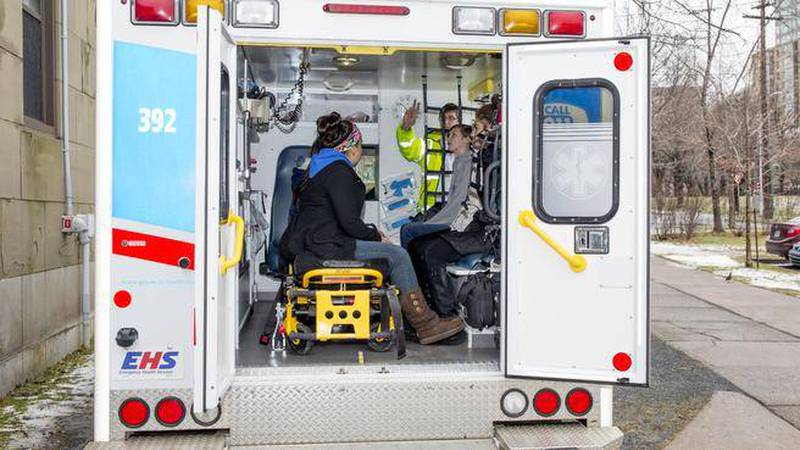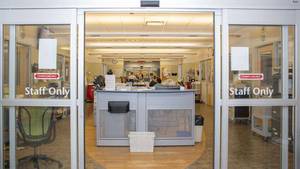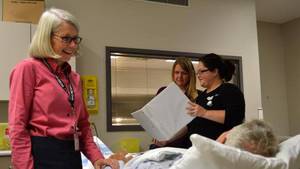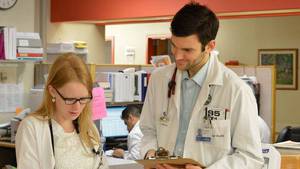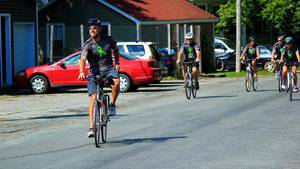A group of students crowd around an ambulance parked at the QEII’s VG site. A paramedic stands hunched inside, describing a fictional motor vehicle collision on Highway 102 — and asks what would you do? He then describes what it means to be a paramedic and how he deals with different situations in paramedicine. This is part of a high school co-op volunteer program at the QEII. Every year, 12 lucky students get first-hand, in-depth experience in what it’s like to work in health care.
For eight months and one high school credit, students experience first hand what it’s like to work in a hospital. Students are assigned four different placements throughout the QEII, completing 15-18 hours in each one. Student placements include: Cancer Care, Diagnostic Imaging, Pharmacy, Cardiac Care, Ear Nose and Throat, Nephrology and Transplant, Orthotics and Prosthetics, Mental Health, 9A General Surgery and Physiotherapy in the Geriatric Day Hospital.
Staff offer a variety of experiences with different members of the healthcare team in each area. Volunteer Services also organizes three additional career exploration days during the year, including a day in the labs and two mini career fairs. These career fairs offer information on even more healthcare careers, such as the Health Sciences Programs and Paramedicine.
Mentors, such as Harold Richards in the Diagnostic Imaging Department, show the students various facets of their jobs. “They really seem to enjoy it. A lot of them typically don’t realize how many different types of things go on in a hospital,” says Harold, an X-ray Technologist for more than 21 years.
In Diagnostic Imaging, where Harold works, students observe General Radiography, the Emergency Department, the CT Scan (Computed Tomography), the Intensive Care Unit and the Operating Room — the last of which Harold says is the most popular with the co-op students.
“I’m very impressed with how inquisitive they are,” he says. “It makes me feel good to pass on what I’ve learned to young minds like that.”
Two former high school co-op students, and current fourth-year Dalhousie University nursing students, Caitlin Galbraith and Alanna Langille, say their experiences in the high school co-op volunteer program were extremely beneficial.
“It really gave us exposure to different careers — not just nursing,” Caitlin says. “I was a lot more comfortable going into my first clinical [in nursing school] just because I had dealt with patients before, and had communicated with families.
“I learned that each profession played an important role in the health of a patient. I didn’t even know some of the professions existed.”
Having the hospital environment and patient exposure prior to entering university was the best part of the co-op program, according to Alanna.
Berni Duda, Coordinator of Volunteer Services, including the high school co-op volunteer program, says it’s a unique program for students at a time when they’re trying to figure out what to do after high school.
“Students discover that there are hundreds of careers in health care. They are able to determine if they are comfortable working in a hospital setting which often confirms whether or not it’s the right career path for them,” says Berni. “They also learn about the patient, what they’re going through, what their concerns are, what they worry about and what they’re grateful for — that’s a tremendous learning opportunity for the student.”
Trevor Doyle, a Cooperative Education teacher, and Debra Wilson, an Option and Opportunities teacher, both from Citadel High School, visit classes to inform students of the QEII volunteer program, interview and then choose the candidates for the program.
Because students miss one afternoon of classes each week, Trevor and Debra are very careful about whom they choose to participate — students must do well in school, be respectful, and above all, curious.
Antonio Garcia, a Grade 12 student at Halifax West High School and current co-op student, says he’s really enjoyed his experience so far.
“I’ve loved it. Most of all, I’ve learned respect — for the staff and especially for the patients,” Antonio said. “It’s not all doom and gloom for them, their positive attitudes have surprised me.”

